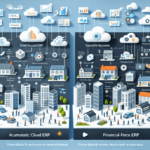SAP Business One vs Acumatica Cloud ERP
In the competitive landscape of enterprise resource planning (ERP) software, SAP Business One and Acumatica Cloud ERP stand out as top choices for small and mid-sized businesses. Selecting the right ERP system is crucial for optimizing operations, enhancing productivity, and driving growth. This comprehensive comparison delves into the key differences, pricing models, features, integration capabilities, and real-world implementations of both solutions to help you make an informed decision.
Overview of SAP Business One and Acumatica Cloud ERP
SAP Business One is a comprehensive ERP solution tailored for small to mid-sized enterprises. It encompasses various modules such as financial management, sales and customer management, purchasing and inventory management, and business intelligence. Acumatica Cloud ERP, on the other hand, is a cloud-native ERP system offering features like financial management, project accounting, distribution management, customer and employee management, and more. Both platforms emphasize user-friendliness and customization to cater to diverse business needs.
While SAP Business One offers both on-premise and cloud deployment options, Acumatica Cloud ERP is exclusively cloud-based, providing greater accessibility and ease of maintenance. This fundamental difference influences deployment flexibility, scalability, and total cost of ownership for businesses.
Key Differences Between SAP Business One and Acumatica Cloud ERP
Deployment Models
SAP Business One offers the flexibility of both on-premise and cloud deployments, allowing businesses to choose based on their infrastructure preferences and security requirements. In contrast, Acumatica Cloud ERP is solely cloud-based, which can be advantageous for businesses seeking scalability and remote accessibility without the need for physical servers.
Pricing Structures
The pricing models of SAP Business One and Acumatica Cloud ERP differ significantly. SAP Business One operates on a perpetual licensing model with an estimated starting cost of $3,200 per user, supplemented by annual maintenance fees. This can result in higher upfront costs, especially for organizations with numerous users.
Conversely, Acumatica Cloud ERP employs a subscription-based pricing model, starting at approximately $1,000 per month for basic implementations. This approach allows businesses to manage expenses more predictably and scale their usage based on operational demands.
Customization and Integrations
SAP Business One is highly customizable, enabling businesses to tailor the software to their unique processes and workflows. It also supports extensive integrations with various third-party applications, enhancing its functionality.
Acumatica Cloud ERP offers a standardized interface with a wide array of pre-built integrations, facilitating seamless connectivity with other software solutions. This design emphasizes ease of integration and reduces the complexity typically associated with custom configurations.
Implementation Time
The implementation timeline for SAP Business One is generally longer due to its comprehensive features and customization capabilities. In contrast, Acumatica Cloud ERP's cloud-native architecture allows for quicker deployments, enabling businesses to realize benefits sooner.
Comparison of Pricing Models for SAP Business One and Acumatica Cloud ERP
SAP Business One Pricing
SAP Business One's pricing is primarily based on the number of users, with costs starting around $3,200 per user. This model can lead to substantial initial investments, particularly for organizations with large teams. Additionally, annual maintenance fees contribute to the overall cost structure, making it essential for businesses to consider long-term financial commitments.
Acumatica Cloud ERP Pricing
Acumatica Cloud ERP adopts a subscription-based pricing model, starting at approximately $1,000 per month for basic implementations. This approach allows businesses to allocate costs more evenly over time, enhancing budget flexibility and reducing financial strain. Furthermore, the resource-based pricing ensures that businesses only pay for the functionalities they utilize.
Cost Considerations
While SAP Business One may present higher upfront costs, it offers a robust set of features suitable for businesses with complex operational needs. Acumatica Cloud ERP's subscription model can be more attractive to smaller businesses or those seeking to manage expenses more predictably. Additionally, Acumatica's emphasis on pre-built integrations can reduce the need for costly custom development.
Features and Functionalities Offered by SAP Business One
SAP Business One delivers a comprehensive suite of features designed to streamline various aspects of business operations:
- Financial Management: Comprehensive accounting and financial reporting tools.
- Sales and Customer Management: Tools for managing sales processes, customer relationships, and service management.
- Purchasing and Inventory Management: Efficient handling of procurement, inventory tracking, and supplier management.
- Business Intelligence and Analytics: Advanced analytics for informed decision-making.
- Industry-Specific Solutions: Tailored functionalities for sectors like retail, wholesale distribution, manufacturing, and professional services.
These features enable businesses to manage all operational facets from a single platform, enhancing efficiency and data-driven decision-making.
Features and Functionalities Offered by Acumatica Cloud ERP
Acumatica Cloud ERP provides a robust set of features tailored for dynamic business environments:
- Financial Management: Comprehensive financial tools including accounts payable/receivable, general ledger, and financial reporting.
- Project Accounting: Tools for managing project budgets, time tracking, and resource allocation.
- Distribution Management: Efficient handling of supply chain operations, inventory control, and order management.
- Customer Management: CRM functionalities for enhanced customer relationship management.
- Employee Management: Human resources tools for managing employee information and performance.
- Industry-Specific Solutions: Custom functionalities for industries such as construction, manufacturing, retail, and eCommerce.
Acumatica's flexibility and scalability make it suitable for businesses of all sizes and industries. Its user-friendly interface and mobile accessibility ensure that users can access crucial data and functionalities from anywhere.
Benefits of Using SAP Business One for Small and Mid-Sized Businesses
SAP Business One offers numerous advantages tailored to small and mid-sized enterprises:
- Enhanced visibility into business operations through centralized data management.
- Streamlined processes across various departments, leading to increased efficiency.
- Improved decision-making capabilities with real-time analytics and reporting tools.
- Scalability to accommodate business growth and evolving needs.
- Comprehensive management of financials, sales, purchasing, inventory, and production from a unified platform.
These benefits empower businesses to make informed decisions, respond swiftly to market changes, and optimize their operations for sustained growth.
Benefits of Using Acumatica Cloud ERP for Small and Mid-Sized Businesses
Acumatica Cloud ERP provides several key benefits for small and mid-sized businesses:
- Scalability and flexibility to support business growth and changing requirements.
- Remote accessibility through its cloud-based deployment, facilitating remote work and mobile access.
- Lower total cost of ownership due to its subscription-based pricing model.
- Robust security features to safeguard sensitive business data.
- User-friendly interface with customizable dashboards for tailored user experiences.
- Real-time data access and analysis, enabling informed decision-making and strategic planning.
These advantages help businesses enhance their operational efficiency, maintain data security, and adapt to evolving market demands.
Integration Capabilities of SAP Business One with Other Software Solutions
SAP Business One excels in its ability to integrate with a variety of third-party software solutions, thereby extending its functionality:
- Shopify – for eCommerce management.
- Salesforce – for customer relationship management.
- Microsoft Office 365 – for productivity and collaboration.
- SAP Concur – for travel and expense management.
- Magento – for eCommerce platforms.
These integrations allow businesses to seamlessly manage online sales, inventory, customer relationships, and other critical operations, thereby streamlining processes and enhancing overall efficiency.
Integration Capabilities of Acumatica Cloud ERP with Other Software Solutions
Acumatica Cloud ERP offers extensive integration capabilities with a wide range of software solutions, ensuring comprehensive connectivity:
- Salesforce – for advanced CRM functionalities.
- Magento – for robust eCommerce solutions.
- DocuSign – for electronic signature and document management.
- QuickBooks – for accounting and financial management.
- Xero – for cloud-based accounting.
Additionally, Acumatica integrates with industry-specific software solutions, such as construction management and healthcare management systems, providing a tailored approach to diverse business needs. These integrations facilitate seamless data transfer, reduce manual data entry, and minimize the risk of errors, ensuring accurate and up-to-date records across all platforms.
User Interface Comparison Between SAP Business One and Acumatica Cloud ERP
Both SAP Business One and Acumatica Cloud ERP prioritize user-friendly interfaces, but they cater to different user preferences:
- Customizability: SAP Business One offers a high degree of customization, allowing users to tailor the interface to their specific workflows and preferences. This flexibility can enhance user productivity by aligning the software with existing processes.
- Standardization: Acumatica Cloud ERP features a more standardized interface, which may appeal to users who prefer consistency and simplicity. Its design minimizes the learning curve, enabling quicker adoption and ease of use.
The choice between the two interfaces depends on individual user preferences and the specific operational requirements of the business. Organizations requiring extensive customization may lean towards SAP Business One, while those valuing simplicity and consistency may prefer Acumatica Cloud ERP.
Customer Support Comparison Between SAP Business One and Acumatica Cloud ERP
Effective customer support is critical for the successful implementation and ongoing use of any ERP system. Both SAP Business One and Acumatica Cloud ERP offer robust support options, but there are key differences:
- Support Channels: Both platforms provide support via phone and email. However, Acumatica Cloud ERP offers live chat support, delivering real-time assistance for immediate issues, which can enhance the user experience.
- Knowledge Base and Community: Acumatica Cloud ERP boasts a comprehensive knowledge base and an active community forum where users can seek answers to common questions and engage with other users for support and advice. SAP Business One also provides extensive documentation and community resources but does not offer live chat support.
These additional support channels offered by Acumatica Cloud ERP can significantly improve user satisfaction by providing more accessible and immediate help, especially for time-sensitive issues.
Case Studies Showcasing Successful Implementation of SAP Business One
SAP Business One has been successfully implemented by numerous businesses across various industries, demonstrating its versatility and effectiveness. For example, Currie Group, an Australian packaging equipment supplier, enhanced its inventory management and financial processes post-implementation. The adoption of SAP Business One enabled Currie Group to streamline operations, reduce costs, and improve overall business efficiency. Similarly, various other success stories highlight the transformative impact of SAP Business One on businesses worldwide.
Case Studies Showcasing Successful Implementation of Acumatica Cloud ERP
Acumatica Cloud ERP has also been embraced by a wide range of businesses, underscoring its flexibility and scalability. For instance, YogaOutlet.com, an eCommerce retailer, leveraged Acumatica Cloud ERP to streamline its financial and inventory management processes, facilitating effective scaling and growth. The implementation provided YogaOutlet.com with better data visibility, improved operational efficiency, and the ability to support its expansion objectives. Additional success stories can be found on the Acumatica Customer Stories page, showcasing diverse industry applications.
Future Growth Potential for SAP Business One vs Acumatica Cloud ERP in the Market
The ERP market is evolving rapidly, driven by advancements in cloud technology, artificial intelligence, and machine learning. Both SAP Business One and Acumatica Cloud ERP are well-positioned for future growth, each leveraging their unique strengths:
- SAP Business One: Its versatile deployment options and comprehensive feature set cater to businesses with diverse needs. As businesses continue to seek integrated solutions, SAP Business One's ability to offer both on-premise and cloud deployments ensures it remains a competitive choice.
- Acumatica Cloud ERP: The increasing demand for cloud-based solutions presents significant growth opportunities for Acumatica Cloud ERP. Its cloud-native architecture, coupled with scalability and lower upfront costs, positions it favorably to capture a larger market share as businesses prioritize accessibility, flexibility, and cost-effectiveness.
Overall, while both solutions exhibit strong growth potential, Acumatica Cloud ERP may experience faster adoption rates in the cloud-centric future of ERP systems.
Prospective Buyers’ Guide for Choosing Between SAP Business One and Acumatica Cloud ERP
When evaluating SAP Business One and Acumatica Cloud ERP, businesses should consider the following factors to determine the best fit:
- Deployment Model: Decide whether an on-premise or cloud-based solution aligns better with your infrastructure and operational needs.
- Pricing: Analyze which pricing structure—perpetual licensing or subscription-based—fits your budget and financial strategy.
- Features and Functionalities: Identify the features critical to your business operations and assess which ERP system offers them most effectively.
- Integration Capabilities: Evaluate the ease and extent to which each ERP system integrates with your existing software tools and platforms.
- User Interface: Consider the level of customization and user-friendliness required by your team to ensure smooth adoption.
- Customer Support: Examine the support options available and determine which aligns with your business's support needs and preferences.
- Industry-Specific Offerings: Ensure that the ERP system provides tailored solutions for your industry to meet unique business requirements.
Additionally, leveraging free trials or demos can provide hands-on experience with each solution, facilitating a more informed and confident decision-making process.
Final Verdict: Which Is Better - SAP Business One or Acumatica Cloud ERP?
Choosing between SAP Business One and Acumatica Cloud ERP ultimately depends on the specific needs and priorities of your business. SAP Business One is ideal for organizations seeking a highly customizable solution with flexible deployment options and a comprehensive feature set. In contrast, Acumatica Cloud ERP is well-suited for businesses prioritizing cloud-native solutions, scalability, and predictable subscription-based pricing.
To determine the best fit, businesses should conduct a thorough evaluation of their operational requirements, budget constraints, and long-term strategic goals. By carefully assessing each ERP system's strengths and aligning them with your business objectives, you can select the solution that best supports your path to growth and success.






















